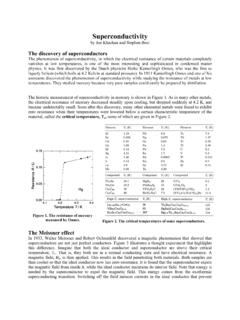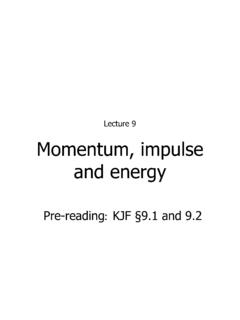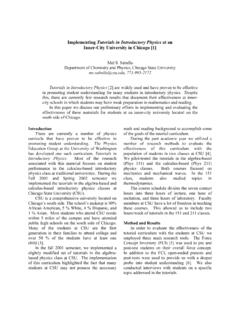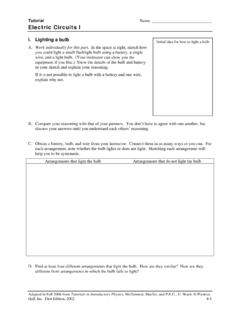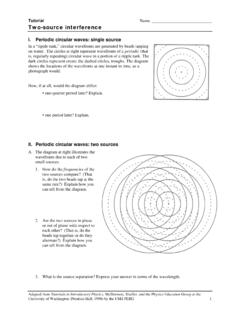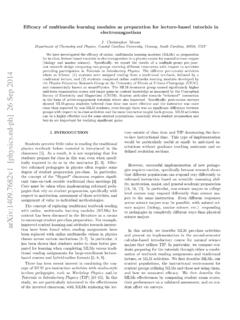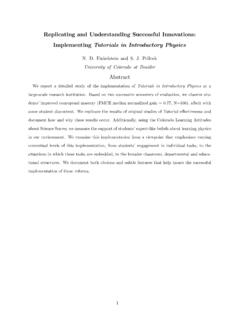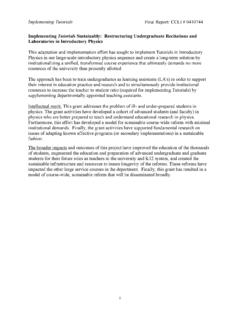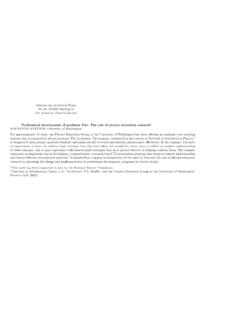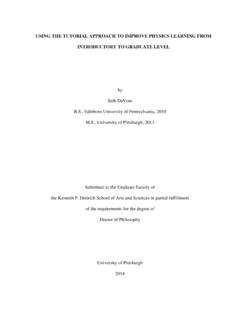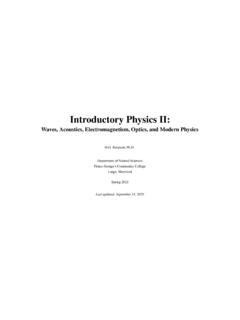Transcription of Solutions to EI3: Electric Potential - School of Physics
1 The Workshop Tutorial Project Solutions to EI3: Electric Potential 23 Workshop tutorials for introductory Physics Solutions to EI3: Electric Potential A. Review of Basic Ideas Electric Potential and Potential energy When a negative charge is placed near a positive charge and released it will be accelerated towards the positive charge. As it accelerates its kinetic energy increases as it moves faster and faster. Where does this energy come from? We know from conservation of energy that when an object gains kinetic energy it must lose some other sort of energy. In this case the charge has Electric Potential energy which is converted to kinetic energy. In the same way a ball held above the ground and released accelerates towards the ground as its gravitational Potential energy is converted to kinetic energy.
2 In the case of gravitational Potential energy we define the zero of gravitational energy to be when an object is on the ground. This is an arbitrary but convenient convention. For charges, we usually define the zero of Electric Potential energy to be when the charges are infinitely far apart. As with gravitational Potential it is really only the changes in Potential energy that are important, hence we usually talk about Potential energy difference. The change in Electric Potential energy, U, as a charge is moved in a uniform Electric field is the Electric force, Fe, acting on the charge, q, times the distance, d, over which it acts, U = We know that the Electric force is the charge times the Electric field, FE = qE, so the change in Potential energy is U = The change in Potential energy is proportional to the charge, q.
3 The change in Potential energy per unit charge is called the Potential difference, V = U/q = The unit for energy is the joule, J, so the unit for Potential difference is the joule divided by the coulomb, J/C which is also called the volt, V, in honour of Alessandro Volta who constructed the first battery in 1800. Potential differences are often referred to as voltages. Using the convention that Electric Potential energy is zero at a point infinitely far away from other charges, we can define the Potential due to a point charge at a distance r from that charge as V = kq/r where k is the Coulomb constant, 109 B. Activity Questions: 1. Equipotentials Equipotentials are surfaces on which the Electric Potential is constant.
4 Field lines represent the magnitude and direction of forces. Field lines are always perpendicular to equipotentials, so you can use equipotentials to draw field lines (or vice versa). Note that there is no work done moving a charge along an equipotential because the force is perpendicular to the displacement, and there is no change in Potential energy. 2. Batteries I A typical electrochemical cell ("battery" in ordinary language) consists of two electrodes, which are often metals, immersed in an electrolyte solution. The materials are chosen so that ions from one of the electrodes are readily soluble in the electrolyte, but when the cell is not connected to anything that process of solution is balanced by a separation of Electric charge across the electrode-electrolyte boundary, which pulls ions from solution back onto the electrode.
5 At the other electrode there is a similar equilibrium with the opposite charge separation giving a balance between ions being deposited on the electrode and dissolved. This gives oppositely charged electrodes with a Potential difference between them. When an external conducting path between the two electrodes is connected, it can supply electrons to one electrode and extract them from the other, destroying the previous equilibria at the electrodes and providing a current in the external circuit. The chemical processes of solution and deposition at the electrodes can proceed and will continue to maintain a Potential difference between the electrodes until the chemicals are exhausted. Energy supplied to the external circuit comes at the expense of the energy of the system of electrodes and electrolytes.
6 In those kinds of batteries which are "rechargeable" (actually they are not recharged, they are re-energised), the processes can be reversed and energy is put back into the chemical system. 3. Measuring voltages The resistance of the wire is much less than that of the resistor. Since the value of the current in both wire and resistor must be the same, using V = IR we can see that the Potential difference across the whole wire must be much smaller than the Potential difference across the resistor. The Potential difference between any two points on the wire is probably so small that you could not measure it. The Workshop Tutorial Project Solutions to EI3: Electric Potential 24 To say that a voltmeter is connected "in parallel" is just a fancy way of saying that you connect its terminals to the two points for which you want to know the Potential difference.
7 Since there is usually something else like a resistor already connected between those two points people say that the voltmeter and the resistor are "in parallel". C. Qualitative Questions: 1. Electric Potential and Potential energy. a. The Electric Potential energy, U, of a charge, q, at some point is the energy required or the work that must be done to move a charge from infinity to that point. For convenience we take the zero of Electric Potential energy to be when the charge is at infinity. The Potential , V, at that point is then the Potential energy per unit charge, , V = U/q. We define the Potential energy of a system of charges as the work done in assembling them, bringing them from infinite separation to their final configuration. b. The Electric Potential energy of a pair of like charges is positive because work has to be done on them to move them from infinitely far apart in towards each other.
8 The change in Potential energy is equal to the work done on the charges, hence the Potential energy is positive. The opposite is true of a negative and positive charge, they do work in coming together, hence they have negative Potential energy. c. The gravitational Potential energy of a pair of masses is negative, as in the case of opposite charges, they are attractive, so they do work as they approach, rather than work having to be done on them to bring them together. 2. Dust precipitators. a. See diagram opposite. b. The dust particle in the chimney has a charge of +1e, hence it will be attracted to the negative plate and repelled by the positive plate, and will move towards point B. c. It will lose Electric Potential energy in doing this, just as a ball falling to earth loses gravitational Potential energy.
9 The dust particle will accelerate, gaining kinetic energy as it moves from O to B. d. A particle with charge 2e will move towards A. It will also lose Potential energy and gain kinetic energy, but as it s charge is twice as great it will have twice the Electric Potential energy as the +1e particle, and twice as much Potential energy will be converted to kinetic energy for a given distance. e. The Electric Potential is highest at point A and lowest at point B; it decreases as you move from positive to negative. D. Quantitative Question: a. The Electric field is the Potential difference per unit distance, E = V/d = 109 V / 500 m = 106 b. See diagram opposite. c. Assuming a uniform field, the Potential difference between the ground and the air at 180 cm above the ground is V = Ed = 106 m = MV.
10 D. Bert, like all humans, is a good conductor, hence he will be the same Potential all over, from his head to his feet, and the Electric field will be distorted around him e. Bert is standing on the ground, hence he is earthed. The earth is at zero volts, so Bert will also be at zero volts, including his head. f. Walking around and swinging a golf club in a thunderstorm is dangerous. The club could act as a lightning rod, as it is long and metallic. If there is a very large Electric field then lightning could strike, and Bert s golf club, and his body, will form a path of low resistance for the current. O B A equipotentials field lines equipotentials field lines




